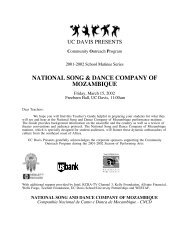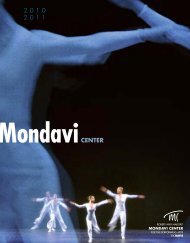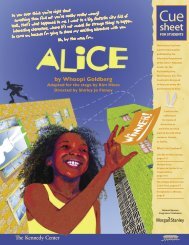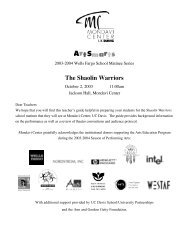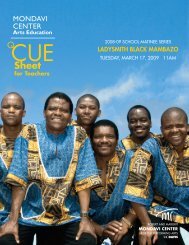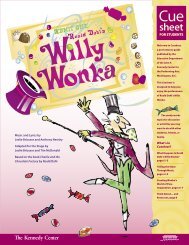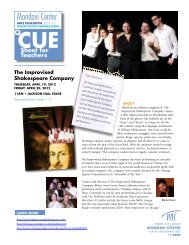Create successful ePaper yourself
Turn your PDF publications into a flip-book with our unique Google optimized e-Paper software.
2005-2006 Wells Fargo School Matinee Series<br />
<strong>Plena</strong> <strong>Libre</strong><br />
October 17, 2005 1:00pm<br />
Jackson Hall, <strong>Mondavi</strong> <strong>Center</strong><br />
Dear Teacher,<br />
We hope you find this CueSheet helpful in preparing your students for the school matinee<br />
presentation of <strong>Plena</strong> <strong>Libre</strong>. This guide, which is intended to be used in conjunction with the<br />
Multicultural Music curriculum guide, provides information about <strong>Plena</strong> <strong>Libre</strong>, Puerto Rican<br />
music, and a brief overview of Puerto Rico. Also included in the guide is a review of audience<br />
etiquette.<br />
<strong>Mondavi</strong> <strong>Center</strong> gratefully acknowledges the institutional donors supporting the Arts Education Program<br />
during the 2005-2006 Season of Performing Arts:<br />
With additional support provided by ArtesAmericas, Bank of America Foundation, River Cats Foundation,<br />
<strong>UC</strong> <strong>Davis</strong> Health System, Teichert Foundation and <strong>UC</strong> <strong>Davis</strong> School/University Partnerships.
PLENA LIBRE<br />
Three-time Grammy nominees, the 13-member <strong>Plena</strong> <strong>Libre</strong> is Puerto Rico’s foremost<br />
exponent of plena: a traditional Puerto Rican rhythm and musical genre which emerged from the<br />
island’s African heritage. <strong>Plena</strong> <strong>Libre</strong> has invigorated this folkdance with innovative arrangements<br />
that combine salsa, samba, merengue, cumbia, and bomba into a veritable sonic fusion. The<br />
ensemble has performed at numerous international music festivals, where their multi-layered<br />
percussion, funky horn work, impassioned vocals, and wild choreography take the audiences into<br />
uncharted territory!<br />
<strong>Plena</strong> <strong>Libre</strong> was formed in 1994 by bassist and bandleader Gary Nuñez, whose mission was<br />
to reinvent and update the plena genre, taking it from its folkloric status—which relegated its<br />
performance to holidays and folk festivals—and turning it into a popular and evolving form. He<br />
recruited an impressive instrumental lineup, to include bass, key boards, timbales, congas, four<br />
trombones, miscellaneous percussion as well as some of the best plena singers (soneros) to be<br />
found in Puerto Rico. With a style that draws on both the traditional and the modern, and<br />
arrangements that mix other Caribbean rhythms and sizzling dance-floor charts with plena, <strong>Plena</strong><br />
<strong>Libre</strong> topped the charts with one hit after another on commercial radio stations in Puerto Rico,<br />
becoming a major force on the Puerto Rican musical scene.<br />
<strong>Mondavi</strong> <strong>Center</strong> ArtSmarts pg. 2
In 1996, <strong>Plena</strong> <strong>Libre</strong> made their way into the mainstream theaters when they began to play<br />
large venues, such as Puerto Rico’s University Theater. The group was the first of its kind to have<br />
their own show at the Roberto Clemente Coliseum, where they were joined by other prominent<br />
Puerto Rican artists including Andy Montañez, Melina León, Domingo Quiñones and Son by Four<br />
in the production "Puerto Rico sabe a <strong>Plena</strong>.” At this point they also began to perform at various<br />
music festivals in the United States, Latin America, Europe and Asia.<br />
<strong>Plena</strong> <strong>Libre</strong>’s list of accomplishments includes an award by the House of Representatives of<br />
Puerto Rico’s Legislature (1999), “Fundación Rafael Cepeda” (1997), and an award given by Loiza,<br />
the town known as the birth place of the bomba y plena, (1995). Other awards include: The “Tu<br />
Música Award”(1999, 1997, 1996 and 1995), “Farándula” (1999) for “Best <strong>Plena</strong> Group,” the<br />
“People’s Choice Awards” for “Best Independent Production” for 3 consecutive years (1995, 1996<br />
and 1997), and the “King Momo Award” for “Best New Orchestra” (1995). <strong>Plena</strong> <strong>Libre</strong> was<br />
nominated for a Latin Grammy in 2001 (Mas <strong>Libre</strong>, RykoLatino) and a Grammy Award in 2003.<br />
Their latest release, ¡Estamos Gozando!, marks their 10 year anniversary and their 10 th commercial<br />
offering. The recording is a tribute to the greatest Puerto Rican plena composers of the century:<br />
Manuel Jiménez "El Canario," Angel Torruellas, César Concepción, Efraín "Mon" Rivera, Rafael<br />
Cepeda, Rafael Cortijo and Ismael Rivera, updated in <strong>Plena</strong> <strong>Libre</strong>’s style.<br />
Discography:<br />
Juntos y Revueltos I (1994)<br />
Cógelo que Ahí Te Va (1995)<br />
<strong>Plena</strong> Pa'Ti (1996)<br />
De Parranda en Natividad (<strong>Plena</strong>, 1997)<br />
<strong>Plena</strong> <strong>Libre</strong> (Ryko Latino, 1998)<br />
<strong>Plena</strong> <strong>Libre</strong> Mix (1999)<br />
Juntos Y <strong>Libre</strong> (Ryko Latino, 1999)<br />
Juntos Y Revueltos II<br />
Más <strong>Libre</strong> (RykoLatino, 2000)<br />
Mi Ritmo (Latin World, 2003)<br />
¡Estamos Gozando! (Times Square Records, 2004)<br />
Evolucion (Times Square Records, forthcoming 2005)<br />
<strong>Mondavi</strong> <strong>Center</strong> ArtSmarts pg. 3
ARTIST BIOGRAPHY: GARY NUÑEZ<br />
Gary Nuñez is <strong>Plena</strong> <strong>Libre</strong>’s founder and director. He graduated magna cum laude from the<br />
Conservatory of Music of Puerto Rico and, before that, from the University of Puerto Rico (with a<br />
major in psychology). Bass player, prolific composer, musical arranger, and record producer,<br />
Nuñez’s career spans more than 20 years as a professional musician and group leader in a wide<br />
variety of musical forms, that include Puerto Rican folkore, Afro-Caribbean music, rock and jazz,<br />
among other styles.<br />
Since his beginnings, Nuñez has had his own independent voice and musical vision. In<br />
1975, while the Latin music world was tuned to “salsa,” he decided to study the history and styles<br />
of Puerto Rican music. He learned to play the “cuarto puertorriqueño” (Puerto Rico’s national<br />
string instrument) and established a group, Moliendo Vidrio, that would contribute to the “New<br />
Song” movement in Puerto Rico. During the 1980s, Nuñez experimented with a fusion of salsa and<br />
jazz, what he called “Caribe Jazz.” <strong>Plena</strong> <strong>Libre</strong> was born out of the hybrid of Gary Nuñez’s<br />
investigations.<br />
Nuñez’s contributions to the development and promotion of Puerto Rican music have been<br />
recognized by different institutions, including the Commission for the 500 th Anniversary of the<br />
Discovery of Puerto Rico and America and the Puerto Rican Institute of Culture.<br />
<strong>Mondavi</strong> <strong>Center</strong> ArtSmarts pg. 4
“The Paradox of Puerto Rican Pride:<br />
<strong>Plena</strong> <strong>Libre</strong> Frees the Rhythm and Salutes the Masters”<br />
Puerto Rican identity is complex. It is not a coincidence that in 1952 this United States<br />
commonwealth’s constitution was instated on July 25, the same date the United States invaded<br />
Puerto Rico in 1898. But any perceived political ambivalence is no reflection on cultural pride, as<br />
seen by the many Puerto Rican pride parades held each summer. This type of pride is at the heart<br />
of <strong>Plena</strong> <strong>Libre</strong>, “Even after five centuries of colonial rule, the Puerto Rican personality is clearly<br />
defined regardless of our relationship to the US,” says <strong>Plena</strong> <strong>Libre</strong> bassist-bandleader Gary Nuñez;<br />
“It is impossible to dilute the character of Puerto Rican people, because we have strong roots. And<br />
plena is an important part of it.”<br />
<strong>Plena</strong> emerged in the late 19 th century when the repertoire of Barbados immigrants mixed<br />
with local genres, and along with the bomba, has been the mainstay of Afro-rooted music of Puerto<br />
Rico. But paradoxically, today many Puerto Rican artists are known for salsa and merengue that<br />
originated in Cuba and the Dominican Republic. “By the early ’70s, the Puerto Rican music<br />
industry came down,” explains Nuñez; “Our rhythms took a back seat to other nations’.” Playing<br />
plena takes on a complex form of pride, affirming Puerto Rican identity within the dominance of<br />
genres that originate elsewhere.<br />
Nuñez asserted Puerto Rican identity in the 1970s with his band Moliendo Vidrio, in line<br />
with the Nuevo Canción (New Song) movements of Latin America, which rallied folk music against<br />
colonialism. After 18 years of putting the cuatro (Puerto Rican guitar) on the map, he was ready for<br />
a new challenge. “Three things kept the plena alive from the ’60s to the ’90s,” says Nuñez; “First,<br />
when people gather for parties, the plena rhythm is always there. Second, plena took center stage<br />
during labor strikes. And third, folklore groups kept the roots of plena alive.” When Nuñez picked<br />
up the torch by forming <strong>Plena</strong> <strong>Libre</strong> in 1994, he sought to reinvent the genre, taking it from<br />
folkloric status. . .and turning it into a living and breathing, popular, evolving form.<br />
Traditionally, plena uses three different-sized hand drums called panderos that are pitched<br />
low-to-high and play interlocking rhythms. The güiro (a Taíno gourd scraper) and the vocalists—<br />
with leader and chorus in call-and-response style—complete the basic ensemble. Over time, the<br />
plena took on different forms—from the addition of the accordion or cuatro to full orchestral<br />
variations. For migrant workers who followed the harvest of different crops, the plena was their<br />
<strong>Mondavi</strong> <strong>Center</strong> ArtSmarts pg. 5
orally transmitted newspaper, informing people of the latest news, and accompanying every<br />
celebration.<br />
Excerpted from the article available at the archive of Rock Paper Scissors world music website:<br />
http://www.rockpaperscissors.biz/<br />
VOCABULARY<br />
<strong>Plena</strong>: A type of folk music in Puerto Rico. <strong>Plena</strong> music is sometimes called “el periodico cantado”<br />
in Spanish, which means “a living newspaper” because it often tells stories about local events or<br />
politicians.<br />
<strong>Libre</strong>: “<strong>Libre</strong>” means free in Spanish.<br />
Panderos: A musical instrument that looks like a tambourine without the cymbals. These hand<br />
held drums are covered with stretched animal skin and come in several different sizes and pitches.<br />
Taíno: The Taíno Indians were the native people in Puerto Rico before the arrival of Europeans in<br />
the early 18 th century. The Taíno created some of the instruments used in plena.<br />
Güiro: This hollowed out gourd instrument is believed to have originated with the Taíno people as<br />
early as the 17 th century. The instrument’s surface has parallel notches cut in one side and is played<br />
with a small metal comb called a pua to produce a rhythmic, rasping sound.<br />
Salsa: A generic term used to describe contemporary Afro-Cuban and Puerto Rican dance music.<br />
<strong>Mondavi</strong> <strong>Center</strong> ArtSmarts pg. 6
ABOUT PUERTO RICO<br />
---map taken from www.lonelyplanet.com<br />
Full country name: Commonwealth of Puerto Rico<br />
Area: 3,515 square miles (9,104 square kilometers).<br />
Population: 3,916,632 (July 2005 estimate)<br />
Capital City: San Juan<br />
People: white (mostly Spanish origin) 80.5%, black 8%, Amerindian 0.4%, Asian 0.2%,<br />
mixed and other 10.9%<br />
Language: Spanish, English (both official)<br />
Religion: Roman Catholic 85%, Protestant and other 15%<br />
Government: commonwealth associated with the US<br />
Head of State: President George W. Bush of the United States (since January 20, 2001)<br />
Head of Government: Governor Anibal Acevedo-Vila (since January 2, 2005)<br />
Major Industries: pharmaceuticals, electronics, apparel, food products, tourism<br />
Agricultural products: sugarcane, coffee, pineapples, plantains, bananas, livestock products,<br />
chickens<br />
Exports: chemicals, electronics, apparel, canned tuna, rum, beverage concentrates,<br />
medical equipment<br />
Major Trading Partners: US 90.3%, UK 1.6%, Netherlands 1.4%, Dominican Republic 1.4% (2002<br />
est.)<br />
Land and Climate<br />
Puerto Rico lies at the eastern end of the major island chain of the Caribbean, the Greater<br />
Antilles. The other islands in the chain—Cuba, Jamaica, and Hispaniola (Haiti and the Dominican<br />
Republic)—are larger and geographically more diverse. The relatively smooth coastline is fringed<br />
<strong>Mondavi</strong> <strong>Center</strong> ArtSmarts pg. 7
y many small islands and cays, especially in the south and east. The island is roughly rectangular<br />
in shape and stretches for 110 miles (180 kilometers) from east to west, with a width from north to<br />
south averaging 35 miles (56 kilometers).<br />
Puerto Rico is topographically rugged; its surface consists largely of hills, slopes, and<br />
mountains. The topographical structure affects Puerto Rico's climate and soils. The soil lacks depth<br />
and plant nutrients, with less than a third—that of the coastal plain—having average to good<br />
qualities for agriculture. Overuse of low-quality and inadequate soil, especially in the hilly regions<br />
and mountainous interior, has contributed to damaging erosion of hillsides and gullies.<br />
Puerto Rico has a tropical climate with little seasonal variation, although local conditions<br />
vary according to elevation and exposure to rain-bearing winds. Northeast trade winds bring heavy<br />
rainfall to the north coast, while the south coast is in a rain shadow. Rain falls each month of the<br />
year, but the heaviest precipitation occurs between May and December.<br />
Plant life is abundant and varied. Tropical rainforests cover parts of the north side of the<br />
island, and thorn and scrub vegetation predominates on the drier south side. Most of the island's<br />
original vegetation was removed through centuries of agricultural exploitation, particularly during<br />
the first two decades of the 20th century, when farm settlers and plantation workers destroyed<br />
large tracts of coastal forest and used the lumber for railroad ties and fuel. The Caribbean National<br />
Forest preserves rare species of orchids and the small green Puerto Rican parrot, an endangered<br />
species. Puerto Rico has more than 200 species of birds, but land animals are mostly confined to<br />
nonpoisonous snakes, lizards, mongooses, and the coquí, a frog whose name is onomatopoeic with<br />
its call (“co-kee!”) and which has become a kind of national mascot. Numerous varieties of fish<br />
abound in the surrounding waters, but edible and inedible species mingle together, limiting<br />
commercial fishing there.<br />
By the last third of the 20th century, government efforts to conserve the remaining natural<br />
forest and to create and increase forest reserves began to have an effect on the serious rates of<br />
deforestation that had reduced the tree cover to about a quarter of the island. Trees were planted<br />
on lands whose agricultural productivity declined as a result of erosion, while small groves were<br />
established in regions of agriculture and pasture. New forests were planted with such fast-growing<br />
trees as eucalyptus, teak, and Honduran pine.<br />
History<br />
Puerto Rico was known as Borinquén to the indigenous Arawak Indians who had settled the<br />
Greater Antilles as traditional hoe-and-garden cultivators, fishermen, and gatherers. When<br />
<strong>Mondavi</strong> <strong>Center</strong> ArtSmarts pg. 8
Europeans first settled the island, the prosperity of the Arawaks prompted the notion that here<br />
indeed was a “rich port.” Imported diseases soon decimated the Arawak population. From a<br />
population of more than 30,000 before the arrival of the Europeans, missionary reports of 1515<br />
recorded only 4,000.<br />
Christopher Columbus claimed Puerto Rico for Spain in 1493, but the arrival of the first<br />
governor—Juan Ponce de León—and the first Spanish settlers did not occur until 1508. The island<br />
remained Spanish despite harassment and conquest attempts by buccaneers and pirates and English<br />
and Dutch expeditions. To defend the island against these threats, two forts—El Morro and San<br />
Cristóbal—were built to guard the approaches to San Juan harbor. Defense of these forts foiled<br />
attempts by Sir Francis Drake in 1595, by another English fleet in 1598, and by the Dutch in 1625<br />
to capture Puerto Rico for their respective empires. The defeat of the British in 1797 finally<br />
thwarted that country's designs on the island, and the Spanish realm was kept intact.<br />
Puerto Rico was characterized primarily by peasant agriculture until the early 19th century,<br />
when Spanish law was changed to allow unrestricted trade. Concentration of land into the hands of<br />
a small elite followed, and export-oriented agriculture became prominent.<br />
Puerto Ricans revolted against Spanish domination in 1868, and in 1897 home rule was<br />
established. Puerto Rico was given the status of a Spanish dominion. This autonomy was short<br />
lived, however, as the United States defeated Spain in the Spanish-American War and was ceded<br />
Puerto Rico in 1898.<br />
By the Jones Act of 1917, Puerto Ricans became American citizens, and Puerto Rico became<br />
an unincorporated territory of the United States. Partial self-government was granted in 1947,<br />
enabling citizens to elect their own governor. Further autonomy was granted in 1951, when Puerto<br />
Ricans wrote their own constitution and elected a nonvoting commissioner to represent them in<br />
Washington, D.C.<br />
Puerto Ricans, or puertorriqueños, have an intermingled Spanish, U.S., and Afro-Caribbean<br />
culture. The island's social and economic conditions are generally advanced by Latin American<br />
standards, partly because of its ties with the United States (including the presence of U.S.-owned<br />
manufacturing plants and military bases in the commonwealth). Puerto Ricans now have most of<br />
the benefits of American citizenship. However, domination of Puerto Rico by the United States is a<br />
major political issue. Some Puerto Ricans object to being ineligible to vote in presidential elections<br />
despite being subject to service in the armed forces. The independistas call for total independence as<br />
a nation-state, others support the present commonwealth status, and a third group hopes to see<br />
Puerto Rico become the 51st state.<br />
<strong>Mondavi</strong> <strong>Center</strong> ArtSmarts pg. 9
Cultural Life and the Performing Arts<br />
The idealized folk hero of Puerto Rico is the jíbaro, a rustic, independent hill-farmer whose<br />
status in local song and story is similar to that of the gaucho of Argentina. However, modern<br />
Puerto Rican cultural life is a blend of North American and Latin, African, and Caribbean forms, as<br />
is evident in much of the island's dance, music, art, literature, and sports. African influences are<br />
found in food, music, and art. Music festivals, museums in Ponce and San Juan, and theatrical<br />
performances encourage hispanidad, or Spanish customs. Puerto Ricans have worked to preserve a<br />
Latin heritage while welcoming U.S. economic and social novelties, engendering a cultural<br />
dilemma that has often catalyzed political debate.<br />
Puerto Rican musicians, composers, and actors have made marks far beyond their island's<br />
narrow shores, and some have been counted among the world's most famous pop-culture figures.<br />
Notable Puerto Rican stage and screen performers include the Academy Award winners José Ferrer,<br />
Rita Moreno, and Benicio Del Toro, as well as Raúl Juliá; also of Puerto Rican descent are Chita<br />
Rivera and Jennifer Lopez.<br />
Among 19th-century composers are Manuel Tavárez and Juan Morel Campos, both known<br />
for their dance melodies. The popular 20th-century songwriter Rafael Hernández is still revered<br />
throughout Latin America. The Spanish-born cellist Pablo Casals, whose mother was Puerto Rican,<br />
moved to the island in 1956 and founded the world-famous classical music festival there that bears<br />
his name. Puerto Rican musicians have included the classical pianist Jesus María Sanromá, opera<br />
singers Antonio Paoli and Justino Díaz, and popular musicians Tito Puente, José Feliciano, and<br />
Ricky Martin.<br />
Latin jazz and salsa are enjoyed throughout the island; also popular are merengue, rock,<br />
rap, the Afro-Caribbean bomba, and the tambourine-marked plena. Many musical groups preserve<br />
jíbaro (folk) music by playing such instruments as the cuatro (a small guitar carved from a single<br />
piece of wood), the marímbula (a wooden box on which are mounted tuned metal tongues), the<br />
güiro (a percussive gourd that is also a popular decoration), drums, and maracas.<br />
Excerpted from "Puerto Rico." Britannica Student Encyclopedia from Encyclopædia Britannica<br />
Online. [Accessed August 28, 2005].<br />
<strong>Mondavi</strong> <strong>Center</strong> ArtSmarts pg. 10
QUESTIONS FOR STUDENTS<br />
Talking with your teacher, friends and family about a performance after attending the theater is<br />
part of the experience. When you share what you saw and felt, you learn more about the<br />
performance. You can now compare ideas and ask questions and find out how to learn even more.<br />
Here are some questions to think about:<br />
1. How would you describe <strong>Plena</strong> <strong>Libre</strong>’s music to a friend<br />
2. What feelings did you have while you listened to the music and songs<br />
3. What did you like best and why Was the program different from what you expected<br />
How<br />
4. Did you have a favorite selection A least favorite Explain.<br />
5. Do your parents or grandparents celebrate holidays and special events with music and dance<br />
traditions What are they<br />
6. Can you think of other examples of music that are associated with specific countries or regions<br />
How can music be used to connect people to the ideas and values of their country and/or culture of<br />
origin<br />
This Teacher’s Guide was written by Anett Jessop, Graduate Researcher, <strong>Davis</strong> Humanities Institute<br />
<strong>Mondavi</strong> <strong>Center</strong> ArtSmarts pg. 11
ATTENDING THE THEATER<br />
What is expected of student audiences at the matinee:<br />
* Enter the auditorium quietly and take seats immediately;<br />
* Show courtesy to the artist and other guests at all times;<br />
* Demonstrate appreciation for the artist’s work by applauding at the appropriate times;<br />
* Refrain from making unnecessary noise or movements;<br />
* Please eat lunch before or after the performance to avoid disruption;<br />
* Please turn off cell phones and pagers;<br />
* Flash photography is strictly prohibited;<br />
* Relate any information acquired from the pre-matinee discussion to the new information gained from<br />
the matinee.<br />
What you can expect of your experience in a performing arts theater:<br />
A theater is a charged space, full of energy and anticipation. When the house lights (the<br />
lights that illuminate the audience seating) go down, the excitement level goes up! Theaters are<br />
designed so that the voices of the singers and actors and the music of the musicians can be heard.<br />
But this also means that any sound in the audience: whispering, rustling of papers, speaking and<br />
moving about, can be heard by other audience members and by the performers. Distractions like<br />
these upset everyone’s concentration and can spoil a performance.<br />
The performers on stage show respect for their art form and for the audience by doing their<br />
very best possible work. The audience shows respect for the performers by watching attentively.<br />
Applause is the best way for audience members to share their enthusiasm and to show their<br />
appreciation for the performers. Applaud at the end of a performance! Sometimes the audience will<br />
clap during a performance, such as after a featured solo. Audience members may feel like laughing<br />
if the action on stage is funny, crying if the action is sad, or sighing if something is seen or heard<br />
that is beautiful. Appreciation can be shown in many different ways, depending upon the art form<br />
and the culture(s) of the people in the audience. While the audience at a dance performance will sit<br />
quietly, other types of performance invite audience participation.<br />
<strong>Mondavi</strong> <strong>Center</strong> ArtSmarts pg. 12



